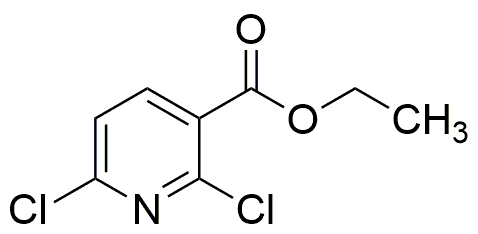Ethyl 2,6-dichloronicotinate is widely utilized in research focused on:
- Pesticide Development: This compound serves as a key ingredient in formulating pesticides, particularly in targeting specific pests while minimizing harm to beneficial insects.
- Pharmaceutical Synthesis: It is used in the synthesis of various pharmaceuticals, offering a pathway to develop new drugs with enhanced efficacy and reduced side effects.
- Biological Research: Researchers employ this compound to study its effects on biological systems, helping to uncover mechanisms of action in cellular processes.
- Material Science: Ethyl 2,6-dichloronicotinate is explored in creating advanced materials, such as polymers with tailored properties for specific applications.
- Analytical Chemistry: The compound is utilized as a standard in analytical methods, aiding in the accurate detection and quantification of related substances in various samples.
General Information
Properties
Safety and Regulations
Applications
Ethyl 2,6-dichloronicotinate is widely utilized in research focused on:
- Pesticide Development: This compound serves as a key ingredient in formulating pesticides, particularly in targeting specific pests while minimizing harm to beneficial insects.
- Pharmaceutical Synthesis: It is used in the synthesis of various pharmaceuticals, offering a pathway to develop new drugs with enhanced efficacy and reduced side effects.
- Biological Research: Researchers employ this compound to study its effects on biological systems, helping to uncover mechanisms of action in cellular processes.
- Material Science: Ethyl 2,6-dichloronicotinate is explored in creating advanced materials, such as polymers with tailored properties for specific applications.
- Analytical Chemistry: The compound is utilized as a standard in analytical methods, aiding in the accurate detection and quantification of related substances in various samples.
Documents
Safety Data Sheets (SDS)
The SDS provides comprehensive safety information on handling, storage, and disposal of the product.
Product Specification (PS)
The PS provides a comprehensive breakdown of the product’s properties, including chemical composition, physical state, purity, and storage requirements. It also details acceptable quality ranges and the product's intended applications.
Certificates of Analysis (COA)
Search for Certificates of Analysis (COA) by entering the products Lot Number. Lot and Batch Numbers can be found on a product’s label following the words ‘Lot’ or ‘Batch’.
*Catalog Number
*Lot Number
Certificates Of Origin (COO)
This COO confirms the country where the product was manufactured, and also details the materials and components used in it and whether it is derived from natural, synthetic, or other specific sources. This certificate may be required for customs, trade, and regulatory compliance.
*Catalog Number
*Lot Number
Safety Data Sheets (SDS)
The SDS provides comprehensive safety information on handling, storage, and disposal of the product.
DownloadProduct Specification (PS)
The PS provides a comprehensive breakdown of the product’s properties, including chemical composition, physical state, purity, and storage requirements. It also details acceptable quality ranges and the product's intended applications.
DownloadCertificates of Analysis (COA)
Search for Certificates of Analysis (COA) by entering the products Lot Number. Lot and Batch Numbers can be found on a product’s label following the words ‘Lot’ or ‘Batch’.
*Catalog Number
*Lot Number
Certificates Of Origin (COO)
This COO confirms the country where the product was manufactured, and also details the materials and components used in it and whether it is derived from natural, synthetic, or other specific sources. This certificate may be required for customs, trade, and regulatory compliance.


